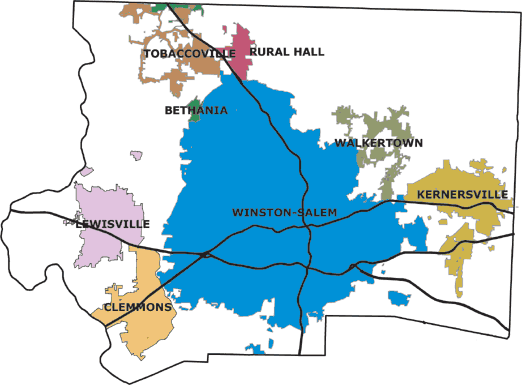The Salem housing market, while not as frenzied as others, is quietly doing very well. Strong market fundamentals are combining with great affordability to make the North Carolina city a very attractive area for both living and real estate investing.
Even though appreciation rates have slowed down in the Salem housing market, price gains are vastly outpacing the national average. In fact, over the course of a year, Salem home prices have increased 8.1 percent. National home prices, on the other hand, have increased by 5.7 percent. Nonetheless, the current median home price in Salem is way below that of the national average – suggesting that the North Carolina city is more affordable than ever. That said the average home price in the Salem housing market is $134,500, where as the national average is 4208,067.
Despite a slowdown in appreciation rates, prices are still up from last year. In fact, both Salem real estate investing and the whole of the housing market are better off than they were at this point 12 months ago. Homeowners have seen equity return, and activity with it. The following highlights how much equity has been gained relative to the year of the home’s purchase:
- Homes purchased in the Salem housing market one year ago have appreciated, on average, by $11,997. The national average was $14,170 over the same period.
- Homes purchased in the Salem housing market three years ago have appreciated, on average, by $24,685. The national average was $53,857 over the same period.
Gains in home values and principle payments made by owners in Salem over the last three years have boosted total equity growth in the area. Of particular importance, however, are the contributions made to the Salem housing market by local economic and demographic fundamentals. A sturdy job market looks to provide stable supply and demand. It is a perfect storm. Unemployment in the area is well below the national average at 4.5 percent. If that wasn’t enough, Salem had a net gain of 3,800 jobs over the course of last year.
“The improvement in North Carolina’s factory sector over the past year has been a key element of the strengthening in the overall economy and sharp decline in the unemployment rate. It appears to be bringing folks back into the workforce, which is slowing the decline in the labor force,” said Mark Vitner, a senior economist with Wells Fargo Securities.
The Salem housing market has certainly taken the recovery and run with it. Strong fundamentals continue to support the economy and local real estate. In fact, Salem – at first glance – looks to be keeping pace with some of the most popular metros in America. However, the Salem housing market has one thing going for it that cities like San Diego and San Francisco can’t even fathom: affordability. Salem real estate is actually more affordable than most markets across the country. To put things into perspective, Salem homeowners spend about 7.6 percent of their income on monthly mortgage payments. The average homeowner across the country, on the other hand, spends about 15.1 percent of their income on mortgage obligations. Perhaps even more importantly, affordability looks to increase in Salem.
Believe it or not, but affordability is even more prevalent in Salem real estate investing. Foreclosures offer investors a great opportunity to secure deals at an attractive price. According to RealtyTrac, the Salem housing market has about 862 foreclosures. Accordingly, nearly 900 properties are either in default, have been repossessed by banks or are to be placed up for auction. While the amount of foreclosures on the market has actually dropped 8 percent since last year, there is still plenty of opportunities to get into Salem real estate investing. If the opportunity doesn’t peak your interest, hopefully the discounts will. Non-distressed homes in Salem sell for about $115,050. Distressed homes, however, have an average sales price of $56,356 – more than 50 percent less than non-distressed homes. That is a savings of nearly $59,000 per property
The number of Salem homeowners listed as more than 90 days behind on mortgage payments reached a three-year low of 3.53 percent in January, compared with 3.62 percent in December and 4.33 percent in January 2014. By comparison, the North Carolina rate dropped year over year from 4.18 percent to 3.43 percent in January, and the national rate from 5.01 percent to 4.02 percent.
At 56.8 percent, the overwhelming majority of foreclosures in the Salem housing market are in default, or pre-foreclosure. Another 33.1 percent are expected to be placed up for auction, which actually represents about a 20 percent increase over last year. The remaining 10.1 percent are properties that have been repossessed by the banks. Regardless of where the foreclosures come from, they all offer a great opportunity to get into Salem real estate investing.
According to numbers released by Trulia, the Salem housing market has approximately 1,463 homes for sale. Moreover, 1,643 homes have recently sold, suggesting that supply and demand is in balance. The local market doesn’t necessarily favor buyers or sellers.
The Salem housing market has strong fundamentals working in its favor. Supply and demand is receiving a lot of support from a strong job market and affordability continues to bring in new owner prospects. Both Salem real estate investing and residents are looking to take advantage of rising home prices. While the Salem housing market is not as brisk as some of the most popular metros, it is doing very well for itself. Economists expect this area to continue to trend in a positive direction for the foreseeable future.
Salem Housing Market Summary:
- Current Median Home Price: $134,500
- 1-Year Appreciation Rate: 8.1%
- Unemployment Rate: 4.5%
- 1-Year Job Growth Rate: 0.9%
- Population: 236,441
- Median Household Income: $42,563

